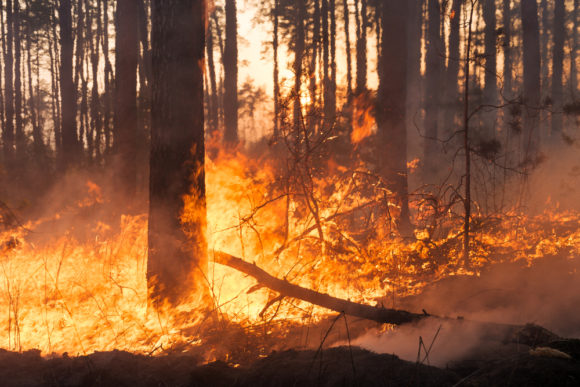California, which has seen its eight largest recorded wildfires since 2017, is in a “heightened state of alert,” according to a new report that calls for urgent policy actions.
The report was released on Wednesday and also discussed in a Zoom conference by a panel of experts the same day.
The panel coincidentally occurred the same day that California Insurance Commissioner Ricardo Lara ordered insurance companies to preserve 209,881 residential property insurance policies held by wildfire survivors included in an earlier emergency declaration, bringing the total statewide to 618,700 policyholders across 31 counties who were granted temporary protection from non-renewals or cancellations by insurers.
Janet Ruiz, strategic communication director at the Insurance Information Institute, moderated the panel discussion on the economic impact of California’s recent wildfires. The Bay Area Council Economic Institute hosted one-hour panel discussion and released its latest report on the issue, “The True Cost of Wildfires: Analyzing the Impact of Wildfires on the California Economy.” The Bay Area Air Quality Management District and CSAA Insurance Group were the event’s sponsors.
The panel discussion’s four panelists were:
- Laurna Castillo, senior vice president of state product management for CSAA Insurance Group
- Mark Heine, fire chief of the Sonoma County, California Fire District
- Jessica Morse, deputy secretary of forest and wildland resilience for the California Natural Resources Agency
- John Watts, senior counselor for U.S. Senator Dianne Feinstein (D-Calif.)
The report was prepared by the Bay Area Council Economic Institute using public data, and is available on the group’s website.
It highlights an “urgent need” for policy action, and notes that longer wildfire seasons and more destructive fires have “pushed much of California into a heightened state of alert.”
“The acreage burned per wildfire has been increasing drastically in recent years, resulting in more destructive wildfire events and larger economic losses,” the report states.
According to the report, California’s eight largest recorded wildfires have all occurred since 2017, and in terms of insured losses the 2020 wildfire season is estimated to have produced between $5 billion and $9 billion in destruction, that’s following wildfire seasons in 2017 and 2018 that each recorded more than $10 billion in insured losses.
The report explores the health and economic costs of California wildfires with a focus on the Bay Area, and it outlines immediate and long- term strategies for intervention and resilience, including investing in forest health projects, improving wildfire preparedness planning, and addressing land use as a “key contributor” to wildfire-related damages.
It also lists several reasons for the increase in destructive California wildfires:
- The increase in acreage burned can be partially attributed to record-breaking droughts over the last decade. Extended periods of drought have created drier conditions more susceptible to fire.
- Climate change is a key factor in increasing the state’s risk for wildfire. Hotter temperatures create drier conditions, exacerbate drought, and make fires easier to spread and harder to put out.
- Drought and warming temperatures have led to elevated levels of tree mortality. More than 147 million trees died in the state between 2010 and 2018, providing fuel for larger fires. Drought and high temperatures also contribute to the spread of bark beetle infestations that can weaken or kill trees, creating more burnable biomass and yielding faster-moving, harder-to-control fires.
- Fire suppression strategies over the decades have resulted in high fuel loads in the state’s forests. By quickly extinguishing fires in forested areas, fire suppression policies have resulted in the buildup of tree debris and plant material.
- An increase in residential development in the wildland-urban interface has led to greater property destruction. Land defined as WUI in California grew between 1990 and 2010, and now encompasses 6.4% of the state’s total land area. Additionally, 45% of homes constructed in the state between 1990 and 2010 were built in the WUI.
In the panel, Watts from Feinstein’s office discussed the President Biden-backed bills in Congress – the infrastructure bill and the Build Back Better bill – which he said would increase funding for firefighting efforts.
“They will quadruple – that’s more than four times – funding for firefighting efforts,” Watts said.
He said the bills include $16 billion to $17 billion to help firefighting efforts, and a provision pushed by Feinstein in the infrastructure bill to increase the number of firefighters and increase federal firefighter pay to close a pay gap with state firefighters.
Heine the fire chief called the bills “a huge step forward.”
He said he’s been talking to state and national lawmakers about funding, adding that “we need funding and educational support” to focus on remediation and other steps to better prepare for and handle wildfires.
He also discussed the impacts that the fires are having on those who have to respond to them, saying they have lost career firefighters due to burnout because they have spent consecutive years fighting numerous and massive wildfires.
“PTSD is off the charts right now for first responders,” he said.
Related:
Was this article valuable?
Here are more articles you may enjoy.



 Longtime Motel 6 Spokesman Tom Bodett Settles Lawsuit Against Chain
Longtime Motel 6 Spokesman Tom Bodett Settles Lawsuit Against Chain  Litigation Funding, Other New Laws in SE States Could Impact Liability Insurance
Litigation Funding, Other New Laws in SE States Could Impact Liability Insurance  Aon Extends Employment Agreement With CEO Case
Aon Extends Employment Agreement With CEO Case  Target, Walmart, Whole Foods Targeted in Botulism Suits
Target, Walmart, Whole Foods Targeted in Botulism Suits 

